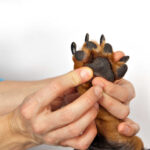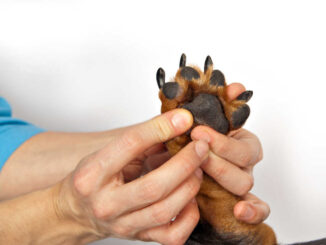
Dogs can develop yeast skin infections anywhere on their body. Some of the most common places would include inside ears, inside skin folds and on the belly, armpits and groin. Certain breeds will be more prone to yeast infections, including Bassett Hounds, Pugs and Westies.
For most dogs, yeast infections on bellies are caused by underlying issues such as hormonal disorders, parasites or allergic skin disease. While there will always be some yeast on the skin, an overgrowth causes discomfort, skin inflammation and itching. In this article, we will review what yeast infections look like on a dog’s belly and discuss treatment options.
What does a yeast infection on the belly look like?

It is not always easy to differentiate between different types of infection e.g. bacterial vs yeast infections. Often the signs are the same. To know the difference, we can swab the lesion or take an impression smear, looking at the microorganisms under the microscope. You can click here to view our pictures of yeast skin infections in dogs.
In practice, this is not always done as it is costly and swabs take time to culture. Most canine skin infections are treated empirically. This means we provide medicine like medicated washes and antibiotics, which will usually clear up most skin infections on the belly.
Some of the more classic signs of a yeast infection include a musty smell, crusting, pink, red or dark (hyperpigmented) skin, mild itching and lichenification (thickening of the skin). With more chronic and advanced infections, the itching will become more severe.


Why does my dog keep getting yeast infections?
If your dog is prone to yeast infections, there will generally be an underlying reason. Rather than simply treating the infections time and time again, we should start asking what we can do to prevent them occurring.
In older dogs, it is a good idea to run some blood tests to check for hormonal disorders, like hypothyroidism. This is especially true when dogs have other symptoms such as lethargy, a change in weight or a change in thirst.
Allergies should always be considered. They tend to present between the ages of 6 months and 5 years and cause itchiness, pink skin and secondary bacterial and yeast infections. When the belly is affected, it is wise to consider environmental allergens such as pollens, grasses and trees.
How can I treat this yeast infection?
Mild and localized belly skin infections can be treated with topical solutions such as Chlorhexidine washes. In some cases, we can use topical anti fungals like Miconazole. Much less commonly, when the infection is longstanding or widespread, oral antifungals will be considered. These can cause a range of side effects so are not used lightly.
When using medicated washes like Chlorhexidine (Hibiscrub), we need to use them in a specific manner. Generally, we dilute them 1:10 in water and apply with cotton wool. We then leave it on for 5-10 minutes, before rinsing with water and pat dry.
Related post: best probiotics for dog yeast infections
When dogs are scratching or licking at their belly, we want to stop this. This can mean the use of a buster collar and perhaps a loose cotton t-shirt. Excessive rubbing and licking can lead to worse itching and more infections being introduced.

With any skin infection, a trip to the vet for a diagnosis and treatment plan is important.
Related posts:
Disclaimer: This website's content is not a substitute for veterinary care. Always consult with your veterinarian for healthcare decisions. Read More.










Be the first to comment